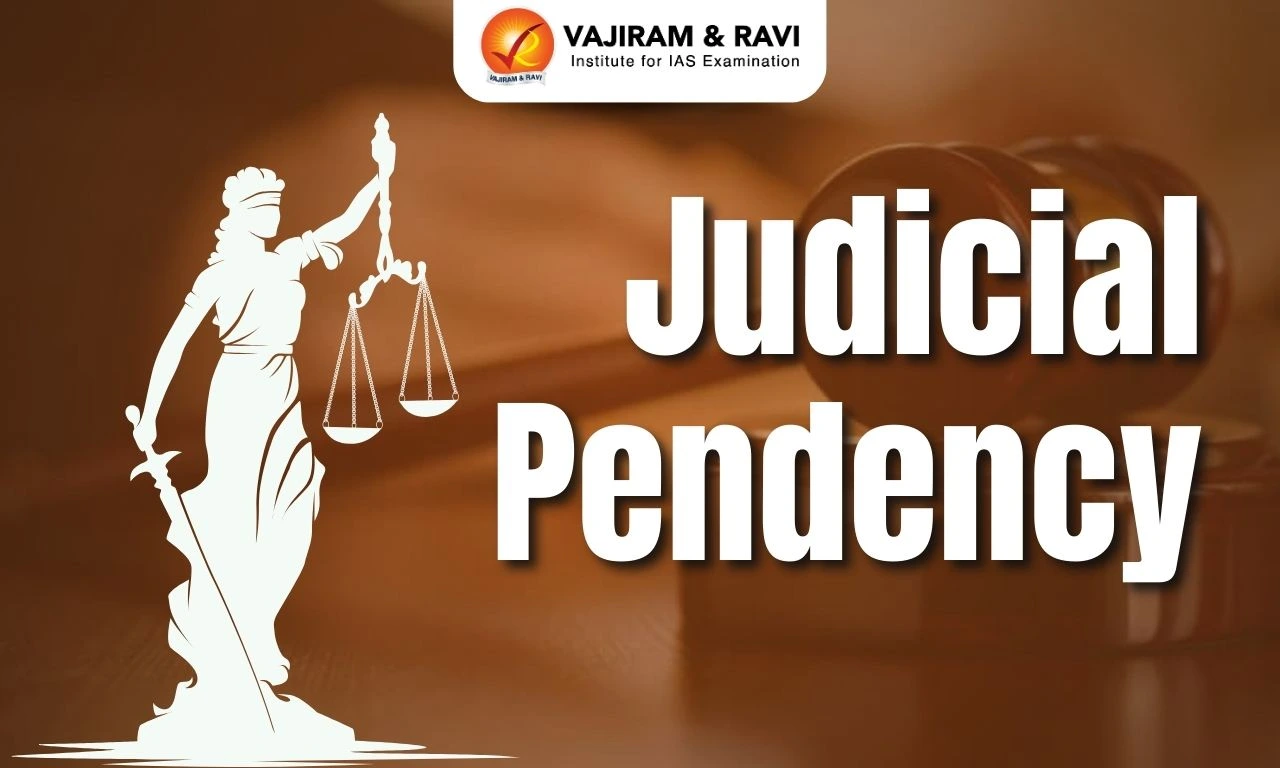What is the current status of the pendency of cases in the Indian judicial system?
The pendency of cases in the judiciary in India refers to the high number of unresolved cases that are pending before the courts.- The problem of pendency is particularly acute at the lower levels of the judiciary, where the majority of cases are filed and where the shortage of judges is most severe.
- Regional Variations: In many states, the number of pending cases is significantly higher than the national average.
- Example: In Bihar, there are over 5 million pending cases, while in Uttar Pradesh, there are over 6 million pending cases.
- Steady growth in pendency of cases: Between 2010 and 2020, pendency across all courts grew by 2.8% annually.
- This implies that if no new cases were to be filed, the time taken by courts to dispose of all the pending cases at the current disposal rate would be 1.3 years for the Supreme Court and 3 years each for High Courts and subordinate courts.
- Pendency in Tribunals and Special Courts: Tribunals and special courts (such as Fast Track Courts and Family Courts), which were set up to ensure speedy disposal of cases, also witness high pendency and vacancies.
- Example: at the end of 2020, 21,259 cases were pending before the National Company Law Tribunal (NCLT).
| Courts | Pendency of cases |
| Supreme Court |
|
| High Courts |
|
| Lower courts |
|
What are the reasons for the high pendency of cases in the Indian Judiciary?
Several reasons exist for the high pendency of cases in the Indian judiciary. Some of the main reasons are- Shortage of judges: There is a shortage of judges in the Indian judiciary. This leads to delays in the resolution of cases, as there is a backlog of cases waiting to be heard.
- Lack of infrastructure: Many courts in India lack the necessary infrastructure and resources to deal with the many cases that are filed. This can contribute to delays in the resolution of cases.
- Complexity of cases: Some cases are complex and require a lot of time and resources to be resolved. This can contribute to delays in the resolution of cases.
- Procedural delays: There are often delays in the legal process due to procedural issues, such as the inability to locate witnesses or delays in obtaining evidence.
- Weak enforcement of court orders: In some cases, court orders are not enforced, which can lead to further delays in the resolution of cases.
- Increased legal awareness: Increased legal awareness has increased the number of cases filed. Further, new mechanisms like Public Interest Litigation (PIL) have also resulted in more cases being filed.
How does the judicial pendency impact the justice delivery system in India?
The pendency of cases in the Indian judiciary can have a significant impact on the justice delivery system in India. Some of these are- Delays in the administration of justice: A large backlog of cases waiting to be heard can result in delays in the resolution of cases, which can take many years or even decades.
- Negative impact on justice quality: Judges may not have the time or resources to fully consider the merits of each case due to paucity of time. This can lead to decisions that are not fully informed or that do not adequately address the issues at hand.
- Burden on the court system: A large number of pending cases can burden the court system, making it difficult for judges to hear and decide cases in a timely manner.
- Loss of faith in the legal system: Long delays can lead to a loss of faith in the legal system among the general public.
- Financial burden on litigants: Prolonged litigation can be costly for litigants, as they have to bear the expenses of prolonged court proceedings.
- Injustice to the victims and witnesses: High pendency can lead to witnesses forgetting the facts of the case, they may die or become untraceable, and victims may lose faith in the justice system.
- Negative impact on the economy: The delays in the justice system can also have a negative impact on the economy, as businesses may be delayed or prevented from moving forward due to unresolved legal disputes.
What steps have been taken to reduce the pendency of cases?
Some steps that have been taken to reduce the pendency of cases:- Virtual court system: In the virtual court system, regular court proceedings are conducted virtually through videoconferencing. It ensures easy access to justice and reduces the pendency of cases.
- e-Courts portal: It has been launched to improve access to justice using technology. It is a comprehensive platform for all stakeholders, such as litigants, advocates, government agencies, police, and citizens.
- E-filing: The facility of submitting court cases electronically through the internet, providing benefits such as saving time and money, not requiring physical presence in court, automatic digitization of case files, and reducing paper consumption.
- e-Payment of court fees and fines: The ability to make online payments for court fees and fines, reducing the need for cash, stamps, and cheques, and integrating with state-specific vendors for convenience.
- Interoperable Criminal Justice System (ICJS): ICJS is an initiative of the e-Committee, Supreme Court to enable the seamless transfer of data and information among different pillars of the criminal justice system, like courts, police, jails, and forensic science laboratories, from one platform.
- Fast track courts - Fast track courts are being set up by the government to expedite the justice delivery and reduce the pendency of cases.
- Alternative Dispute Resolution: ADR mechanisms likeLok Adalats, Gram Nyayalayas, Online Dispute Resolution, etc., ensure timely justice.
What steps could further help reduce the judicial pendency in India?
Some steps can be taken to reduce the backlog of cases in the Indian judiciary:- Increase the number of judges: One way to reduce the backlog of cases is to increase the number of judges in the Indian judiciary. This will allow more cases to be heard and decided more quickly.
- The Law Commission of India (1987) recommended increasing the number of judges to 50 per million people. This was reiterated by the Supreme Court (2001) and the Standing Committee on Home Affairs (2002).
- Expand alternative dispute resolution methods: Alternative dispute resolution methods, such as mediation and arbitration, can resolve disputes more quickly and efficiently than traditional court proceedings.
- Streamline the legal process: Efforts can be made to streamline the legal process, such as by using technology to manage cases and eliminate unnecessary steps. Example: e-courts projects.
Last updated on November, 2025
→ Check out the latest UPSC Syllabus 2026 here.
→ Join Vajiram & Ravi’s Interview Guidance Programme for expert help to crack your final UPSC stage.
→ UPSC Mains Result 2025 is now out.
→ UPSC Notification 2026 is scheduled to be released on January 14, 2026.
→ UPSC Calendar 2026 is released on 15th May, 2025.
→ The UPSC Vacancy 2025 were released 1129, out of which 979 were for UPSC CSE and remaining 150 are for UPSC IFoS.
→ UPSC Prelims 2026 will be conducted on 24th May, 2026 & UPSC Mains 2026 will be conducted on 21st August 2026.
→ The UPSC Selection Process is of 3 stages-Prelims, Mains and Interview.
→ UPSC Result 2024 is released with latest UPSC Marksheet 2024. Check Now!
→ UPSC Prelims Result 2025 is out now for the CSE held on 25 May 2025.
→ UPSC Toppers List 2024 is released now. Shakti Dubey is UPSC AIR 1 2024 Topper.
→ UPSC Prelims Question Paper 2025 and Unofficial Prelims Answer Key 2025 are available now.
→ UPSC Mains Question Paper 2025 is out for Essay, GS 1, 2, 3 & GS 4.
→ UPSC Mains Indian Language Question Paper 2025 is now out.
→ UPSC Mains Optional Question Paper 2025 is now out.
→ Also check Best IAS Coaching in Delhi
Judicial Pendency FAQs
Q1. What is e-courts project?+
Q2. What are some examples of alternate dispute resolution (ADR) methods in India?+
Tags: judicial pendency quest

















